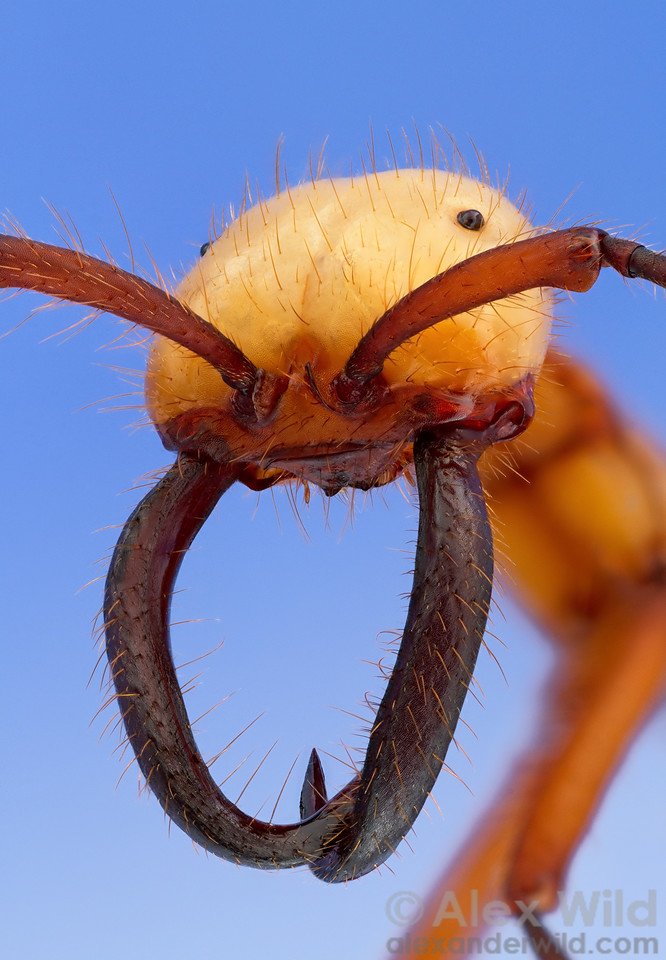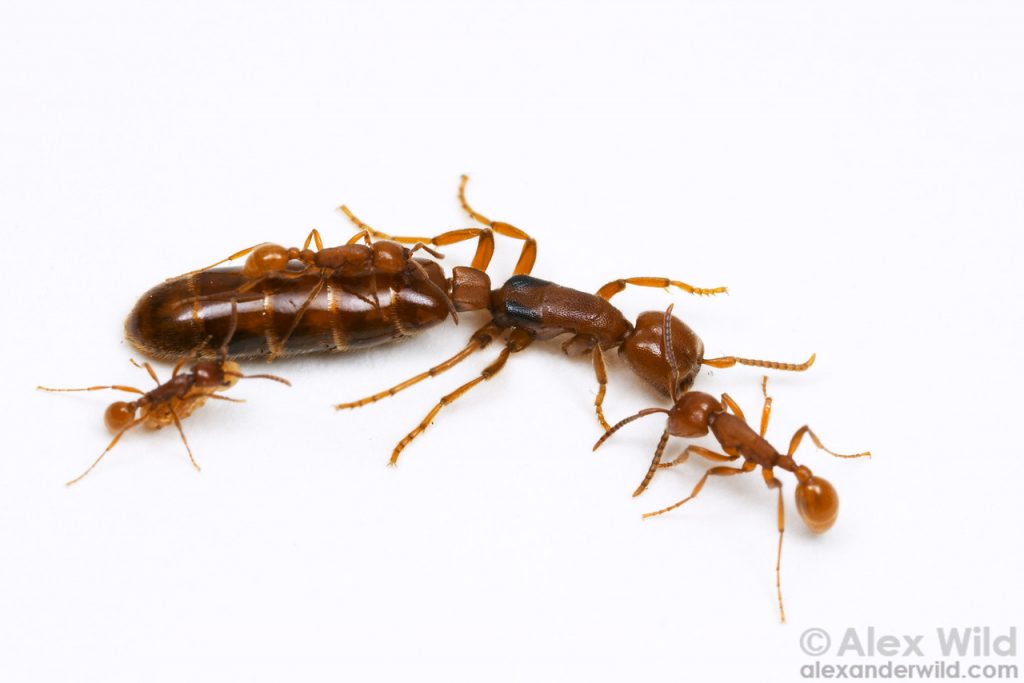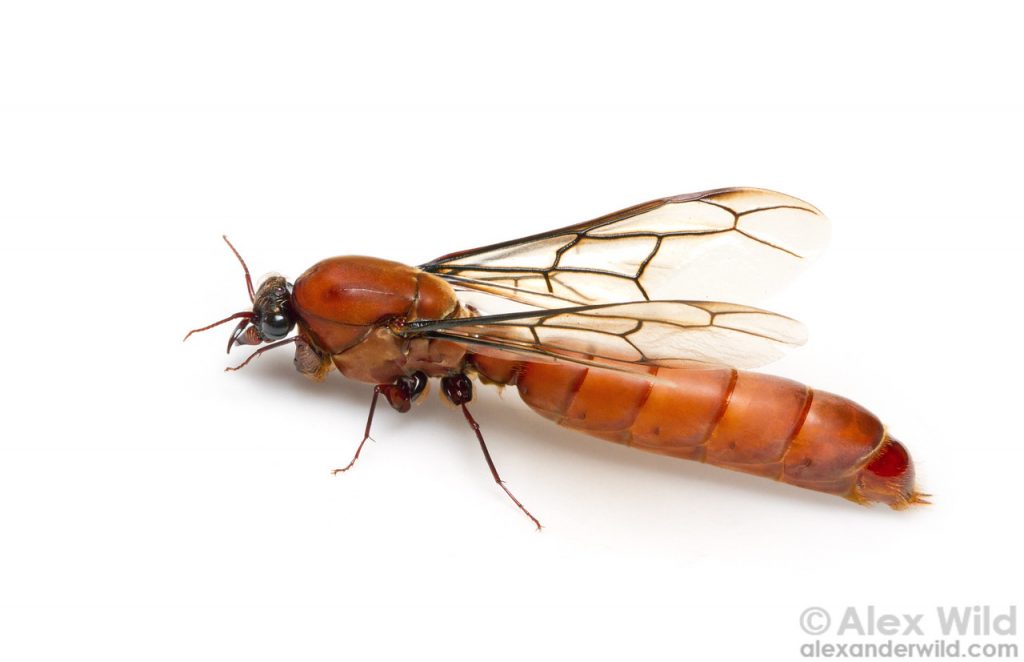When most people think about army ants, they probably see in their mind’s eye, long columns of ferocious ants, swarming over any poor creature that has had the misfortune to be in the wrong place at the wrong time. Or you may picture a large curtain of ants hanging from a dead branch in the jungle. Certainly, these are the most common images we see on the television where army ants are concerned. But do all army ants behave like this? How did army ants develop their characteristic behaviour? How many species of army ant are there? I will endeavour to answer these questions, and more, in this article titled, An Introduction to the Army Ants – the Nomads of the Ant World.
Information in this article was taken from Army Ants: The biology of social predation by William H. Gotwald Jr, and The Lives of Ants, by Laurent Keller and Élisabeth Gordon.
Gotwald opens his excellent book with examples of the names by which these nomadic ants are known in various languages. In German these ants are known as Wandermeisen; in Dutch they are trekmeiren, in French, fourmis voyageuses, and in English, Army Ants.
Old World / New World
There are many species of ant that could be classed as “army ants”. However, the true army ants are those nomadic, or indeed semi-nomadic, species found in Africa and the Americas, known as the Old World and New World, respectively. Army ants are known, and feared, the world over for their en masse attacks, reportedly destroying everything in their path. But do these ants deserve such a label? Do they simply attack anything and everything, relentlessly killing with such a wanton abandonment? Let’s find out.
As hinted above, not all so-called “army ants” are true army ants. There are species of ant that exhibit some behaviours of the army ant, but to a much lesser degree. In this article I will be describing the true army ant.
True army ants are split into two genera, namely; Dorylus (Old World/Africa), and Eciton (New World/Americas). Gotwald Jr tells us that, according to Sean G. Brady of the National Museum of Natural History, Smithsonian Institute, these two genera are descended from a common ancestor. This ancestor lived about 110 million years ago, prior to the spitting apart of the African and American continents. Following this breaking apart of these huge land masses, the army ants evolved into three different sub-families. In the Americas arose the Ecitoninae sub-family, which includes the more widely known, and studied, Eciton genus. There are about 150 species in this sub-family. Whereas, over on the African continent the common ancestor descended into two sub-families; Dorylinae and Aenictinae, with 100 species between them.
Polymorphism
Like most ant species, army ant colonies consist of a queen and workers. True army ants are polymorphic, meaning that the workers come in different sizes. The largest workers are often known as “soldiers”. They tend to take on the role of being the primary defenders of the ant colony. Though, of course, even the smallest workers will defend their nest as required. For example, in the New World army ant Eciton hamatum, the workers have what might be considered “normal” sized mandibles. Whereas those of the soldier caste have huge sickle-shaped jaws.
The size of the individual worker dictates what role it has in the colony; this is known as caste polyethism. This is evident in species of leafcutter ant, where the tiniest workers remain in the nest, tending to the fungus gardens. The larger workers forage outside the nest, and the largest of all, the soldiers, act as defenders and bodyguards.

Ageism
Some tasks are also carried out by ants of certain ages. This is called age polyethism. This is seen in many ant species. In my own Lasius niger colony, the youngest ants remain in the nest. They tend to the queen, brood and nest infrastructure. The older workers forage outside the nest where the danger is greater. This is actually a very prudent job rotation. It is better to send your colony members into the more dangerous situations outside the nest, if they are older and nearing the end of their natural lives; rather than sending out the younger ants that have their “whole lives ahead of them”. Edward O. Wilson once, quite aptly, remarked, humans send their young men to war; ants send their old ladies.
Blind Ants
Most army ants are either totally blind or have very poor eyesight. Some species have no eyes at all, whilst others have eyes composed of just one lens, or ommatidia. Is this a disadvantage to the ants? Not at all. Ants have an array of other sensory inputs that they use, such as their extremely sensitive antennae and feet. Anybody who has seen moving columns of army ants, either with their own eyes, or on the TV, will note that their lack of eyesight seems to not hinder them at all. After all, if you think about it, even those ant species that have the best eyesight are still blind, as far as their eyes are concerned, when they are deep in their underground nests.
Do Army Ants Have Nests?
As I mentioned earlier on, one of the most iconic images of army ants are their vast numbers when marching through the rainforests/jungles. When millions of ants teem almost as one organism, it truly is a jaw-dropping site. What is just as remarkable is the sight of an army ant “bivouac”. Whereas most ants have nests, whether they be underground or inside a tree or plant, the New World species of army ant create a “nest” made up of their own bodies.
When the queen ant is ready to lay eggs, the colony will halt its progression through the undergrowth and come together to form a kind of living “bag”. The workers will link themselves together to form a living bivouac, at the centre of which safely sits the queen and her subsequent brood. Those workers and soldiers not forming part of the bivouac will set out to hunt for food. The ants will bring back huge numbers of prey with which to feed their hungry queen and ravenous larvae. Once the new brood have developed into adult ants, the bivouac breaks up, and the colony moves on.
Migration
What is fascinating about their migration methods is that the ants instinctively know where they have foraged, and having decimated the prey population in one area, they will move off to another area where they have not been before, or at least not for a period of time. By moving away to pastures new they not only find new sources of food, but they allow the areas that have previously raided to regain population of prey.
But back to the question of army ants having nests. Most people are under the impression that army ants do not have physical nests, in the same sense that other ant species have, but this is not entirely correct. Whilst the New World species of army ant, Eciton, do not have physical nests, but rather have their bivouacs as described above, this is not the case of the Old World, Dorylus, army ants.
Dorylus do, in fact, create underground nests when they enter their sedentary, or resting phase, during which the queen lays her eggs. At this time Dorylus will excavate underground nests, albeit a rather rudimentary form of nest. They certainly are not skilful nest builders, but rather create simple excavations, or use natural hollows in the ground in which to nest. Some species of Dorylus will stay in these nests for several months before they enter their nomadic phase once more and move off.
The Impressive Army Ant Queen
Not only is the army ant colony on the march an impressive sight, the army ant queen is an astounding being to behold in her own right. She is the largest ant in the colony and is morphologically different to her workers and soldiers. In fact, Gotwald describes the army ant queen as being … beyond doubt the most atypical queen ant of all species… she is so unusual looking that even an experienced entomologist might not recognise her as an ant.
Like her workers, the army ant queen is totally blind, or practically so. She is much larger than her daughters. But what sets her apart from perhaps all other species of ant queen is her phenomenal egg-laying capabilities. It truly is astounding. Eciton burchelli queens can lay up to 2.4 million eggs per year. Impressive? You’ve seen nothing yet. Dorylus (Anomma) wilverthi queens can lay up to 20-30 million eggs per year! Imagine the size of the ant farm you’d need to keep a colony of those ants!

Should I Stay or Should I Go?
Another interesting fact about army ant queens is that they never possess wings. Whereas the queens of most ant species are born with wings which they remove after successfully partaking in the mating flights, army ant queens are born without wings. Instead of the new queens leaving the colony to find a mate, the mates come to them. More on the male army ant in just a moment. Once the new army ant queen has been mated with a visiting male, she will leave the colony with about half of the worker and soldier population.
This method of colony founding is called budding. The workers and soldiers are not directed as to whether they remain with their mother (the original queen), or whether they depart with their sister (the new queen). Rather each individual ant decides for themselves whether they should stay or go. As far as I am aware it is not understood by entomologists and myrmecologists how each ant makes its personal decision, but it’s a fascinating process, particularly in view of the fact that half decide to stay, and half decide to leave.
It’s not a case of only a handful of the workers and soldiers decide to remain or stay. If not enough ants leave with the new queen then the new colony is doomed, as they will not have enough members to create a bivouac and to forage at the same time. If too many ants leave, then the original colony will have the same problem.
The Sausage Fly
The male army ant is a curious fellow indeed. The male of the Dorylus species of army ant, for example, looks more like, well, a flying sausage. It is a long, tubed-shaped flying insect with tiny head, often formidable looking jaws, and well-developed genitalia. Army ant boys live relatively short lives and have just one purpose; to mate with new queens.
Males in most ant species fly from their parent nests, and search for new queens, which too have flown the nest. Once they have found each other they will mate, and the queen removes her wings and goes in search for a new nesting site. The male, retaining his wings, dies within a few days after mating; his one role in life completed. Interestingly male army ants take a different approach when searching for a queen. The male ant will search for column of marching army ants belonging to a colony other than the one he was born into. Once he finds such a column he lands, and he removes his wings; something that no other ant species male does, as far as I am aware.
The now wingless male ant will then attempt to infiltrate the column of ants with the hope that he will be accepted and lead back to the colony. If he is successful, he will search for the new queen that has been produced by the parent queen within the colony and will live there for up to several weeks. Following this short period, he will mate with the new queen. After this he leaves or is killed by the workers. The newly mated queen then departs her parent colony with half the colony membership, as described earlier. Queens of some army ant species will mate with multiple males.

Are Army Ants Carnivorous?
Gotwald answers this question by explaining that all army ants are carnivorous – with the exception of one known species; that being Dorylus orientalis. This species of Old World (African) army ant are herbivores and are infamous for the devastation they cause to crops. Other than this species, army ants prey on a variety of invertebrates, including scorpions, spiders, beetles, cockroaches, grasshoppers, and other arthropods. Army ants are also known for taking down larger prey, including small mammals. However, most mammals are able to flee from the approach of the deadly army ant swarms. Creatures that are injured or otherwise unable to flee will fall to the mercy of the ants. But the favoured prey of the army ant are other ants, wasps and termites. Huge battles can break out when the army ant raiders penetrate the nests of these aforementioned social insects.
Army ants are indeed a fascinating species of ant, with a reputation for being merciless hunters. I hope you have enjoyed this article, An Introduction to the Army Ants – the Nomads of the Ant World.
Questions
If you have any questions about army ants please feel free to ask them here by adding a comment. Alternatively you can email me using the CONTACT form on my site.